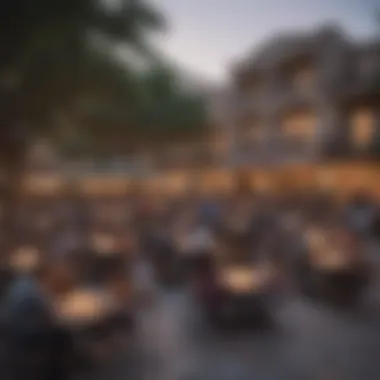Discovering San Antonio's Hidden Neighborhood Gems


Intro
San Antonio is a city where cultural diversity merges seamlessly with rich history, making it an attractive destination for those seeking a new home or a temporary stay. Beyond the famous attractions like the Alamo and the River Walk lies a treasure trove of neighborhoods, each with its own character. These areas are often overlooked but are worth exploring for their unique charm and livability. This guide invites readers to discover the distinctive neighborhoods of San Antonio, uncovering their architectural styles, community vibes, and lifestyle options.
Home Features
Architectural Marvels
The architectural landscape of San Antonio tells a story of its own. Each neighborhood showcases its own distinctive features that reflect both historical influences and modern trends. For instance, the King William Historic District is notable for its 19th-century Victorian-style homes. These structures often display intricate details in their facades, emphasizing craftsmanship that stands the test of time.
In contrast, the Stone Oak area features contemporary designs that merge utility with aesthetics. The homes here often feature open floor plans, large windows, and eco-friendly materials. This area attracts families who appreciate modern amenities while enjoying the natural scenery that surrounds them.
"Each neighborhood has its unique architectural signature, echoing its history and culture."
Unique Design Elements
Beyond the overall architecture, there are fascinating design elements that make San Antonio homes distinctive. Many residences incorporate Spanish influences, evident in the terracotta roof tiles and wrought iron details. In neighborhoods such as Olmos Park, lush gardens and courtyards are common, reflecting a blend of livable outdoor spaces.
Design features often include intricate tile work and colorful murals, showcasing local artists' talents. These elements create an inviting atmosphere that is both functional and visually appealing, resonating with diverse demographics, from young professionals to retirees.
Interior Design Inspirations
Color Palettes and Themes
As we move inside, the interior design of homes in San Antonio presents its own array of inspirations. There is a strong inclination towards warm color palettes that mirror the natural beauty of the surrounding landscapes. Earthy tones such as terracotta, soft browns, and deep greens create a welcoming ambiance. In contrast, some neighborhoods embrace bright, vibrant colors that reflect the city's lively culture.
Themes vary from rustic charm to sleek modernism, leaving homeowners and designers ample room for personal expression. Incorporating local influences into design choices can connect inhabitants to the locale, making every space feel uniquely theirs.
Furniture Arrangement Tips
When it comes to arranging furniture in these diverse living spaces, practicality meets creativity. Here are some essential tips for effective furniture arrangement:
- Consider the Flow: Ensure spaces are open and allow easy movement through rooms.
- Balance the Aesthetics: Distribute furniture thoughtfully to maintain visual balance.
- Create Multi-functional Areas: Especially in smaller homes, use furniture that can serve multiple purposes.
- Use Natural Light: Position furniture to take advantage of natural light, enhancing the atmosphere.
These strategies contribute to creating a space that is not only functional but also reflects individual style and comfort.
Ending
As readers delve into the unique neighborhoods of San Antonio, they will find a myriad of options that cater to various tastes and lifestyles. From the architectural wonders that tell a story of the past to the contemporary design elements that embody modern living, each area offers something distinct. This guide, rich with insights into home features and interior design inspirations, serves as a valuable resource for real estate enthusiasts and travelers alike.
Prolusion to San Antonio
San Antonio stands as a vibrant testament to cultural amalgamation, deeply rooted in history and character. This city, known for its diverse neighborhoods, offers an intriguing exploration of identity and community. Understanding San Antonio is crucial for grasping its real estate dynamics and lifestyle choices.
The neighborhoods in San Antonio are not merely geographical divisions; they represent distinct societies with unique atmospheres and amenities. These areas contain a spectrum of architectural styles and community features, appealing to various demographics. For potential residents and real estate enthusiasts, comprehending the intricacies of these neighborhoods paves the way for informed decisions.
Historical Context
San Antonio's history is a rich tapestry woven from various cultural threads. Founded in 1718, it has witnessed significant events that shaped not just Texas but the whole nation. The city's Spanish colonial origins are evident in its architecture, particularly in structures like The Alamo.
Over the years, San Antonio evolved from a small mission station to a significant military outpost and trade center. Events such as the Texas Revolution left a permanent mark on the collective heritage. Today, historical landmarks coexist alongside modern developments, creating a unique blend of past and present. This historical context enhances the appeal for those interested in real estate, as many buyers are drawn to homes with rich histories.
Cultural Landscape
The cultural landscape of San Antonio is both vibrant and inviting. Known for its year-round festivals, art shows, and music events, the city embodies a spirit of creativity. Neighborhoods like Southtown showcase this artistic vibrancy, being home to numerous galleries and local artists.
The culinary scene is another integral aspect of San Antonio’s culture. It features a melange of cuisines, with Tex-Mex options at the forefront. Local dining experiences reflect the city's diverse heritage, providing a rich backdrop for community gatherings.
In summary, San Antonio is more than just a city. It is a collection of stories, experiences, and cultures intertwined over centuries, making it a compelling place to explore for anyone considering relocation or investment.


The Allure of San Antonio Neighborhoods
San Antonio is a city woven together by distinct neighborhoods, each with its character and charm. Understanding the allure of these neighborhoods goes beyond mere aesthetics. It encompasses the synergy of architecture, community resources, and lifestyle offerings, all of which make these areas not just places to live, but vibrant communities where individuals can thrive. This section will examine what makes neighborhoods in San Antonio appealing, focusing on their architectural diversity and the amenities they provide.
Diverse Architectural Styles
San Antonio’s architectural landscape is a tapestry of styles reflecting its historical evolution and cultural richness. From Spanish Colonial Revival to contemporary designs, each neighborhood showcases unique elements that tell a story. In areas like Alamo Heights, you find stately homes with intricate details and manicured lawns, illustrating the elegance of early 20th-century design.
Conversely, Southtown offers a more bohemian feel, characterized by converted warehouses and art studios housed within historic buildings. This blend of styles attracts not only families but also artists and young professionals seeking a dynamic urban experience. Understanding these diverse architectural styles is crucial for potential residents and real estate investors looking to grasp the aesthetic appeal and market value of different neighborhoods.
The architectural diversity within San Antonio neighborhoods not only adds to their visual appeal but also significantly influences property values and community engagement.
Community Amenities
Another critical aspect of what makes San Antonio neighborhoods so alluring is the range of community amenities available. Well-maintained parks, recreational facilities, and cultural venues contribute to a high quality of life. Neighborhoods like Stone Oak stand out for their family-oriented amenities, including excellent schools, playgrounds, and sports complexes. The availability of such resources is essential for families looking to settle in the area.
Moreover, community events often take place throughout San Antonio, fostering a strong sense of belonging among residents. Festivals, farmers' markets, and social gatherings are staples in neighborhoods like The Dominion, where planned social calendars encourage interaction and community spirit.
Residents and newcomers alike benefit from proximity to grocery stores, healthcare facilities, and entertainment, which creates a convenience factor that is often a deciding factor in choosing a neighborhood.
Neighborhood Profiles
Understanding the distinct neighborhoods of San Antonio provides insight into the city's character and livability. Each neighborhood has unique qualities that appeal to different demographics, lifestyles, and preferences. Delving into these profiles allows potential residents and real estate professionals to make informed decisions. A deep understanding of neighborhood attributes aids in recognizing the social fabric and amenities that can enrich everyday life.
Alamo Heights
Demographics
Alamo Heights has one of the most affluent demographics in San Antonio. This neighborhood attracts families and individuals who seek a blend of history, culture, and educational opportunity. The area boasts a high median income compared to other parts of the city. Residents are often professionals, artists, and educators.
The strong community feels enriched by diversity, which leads to unique local experiences and connections. However, the high cost of living can be a drawback for some potential new residents.
Local Attractions
Alamo Heights is known for its charming local attractions, including boutique shops and art galleries. The neighborhood is home to notable parks such as the Alamo Heights Park, which offers space for outdoor activities.
The San Antonio Art League Museum and the historic homes are also highlights. These elements contribute to a vibrant community, making it a desirable area for those who appreciate culture and arts. However, some may find a limited selection of entertainment options compared to more urban areas.
Real Estate Trends
Real estate trends in Alamo Heights show a steady appreciation in property value. The demand for homes in this neighborhood remains strong, driven by its prestigious school district and desirable location. Properties range from spacious estates to quaint cottages. Investing in real estate here offers long-term value but may require a higher initial investment. The market can be competitive, with homes often selling quickly.
The Dominion
Luxury Living
The Dominion represents the pinnacle of luxury living in San Antonio. This gated community is characterized by its opulent residences and exclusive amenities. Homes are designed with high-end finishes and substantial space. It attracts affluent buyers looking for an upscale lifestyle.
The neighborhood features golf courses, spas, and fine dining establishments, fostering a sense of luxury. Nonetheless, prospective residents must consider that such exclusive living comes with substantial price tags.
Security Features
Security features in The Dominion are robust, making it one of the safest neighborhoods in San Antonio. The gated access and continuous patrols contribute to a secure environment. This is highly appealing for families and individuals concerned about personal safety. Furthermore, advanced surveillance systems and community vigilance enhance this aspect. However, the high security can come at the cost of a less open community feel.
Community Events
Community events in The Dominion are plentiful and tailored for an upscale lifestyle. Residents can enjoy golf tournaments, wine tastings, and charity events. These gatherings foster a strong sense of community among residents. Participation helps build relationships and networking opportunities. Yet, some may find that these events cater predominantly to certain interests and socioeconomic backgrounds, potentially alienating others.
Stone Oak
Family-Oriented
Stone Oak is widely regarded as a family-oriented neighborhood. Its planning includes ample parks, playgrounds, and recreational facilities, making it suitable for families with children. The community atmosphere is supportive and inclusive. Residents often engage in social events. However, the suburban setting may not appeal to those seeking a more vibrant urban experience.
Education Opportunities


Educational opportunities in Stone Oak are regarded highly. The neighborhood houses several well-rated public and private schools. Families place a premium on education, making the local school district a key consideration for many potential residents. The access to both early education and higher learning options offers families an enviable advantage. On the downside, competition for spots in top schools can be intense.
Recreation Facilities
Recreation facilities in Stone Oak are abundant. Residents benefit from various options, including sports complexes, walking trails, and fitness centers. The community prioritizes health and wellness, fostering an active lifestyle. Families enjoy organized sports leagues and community-based fitness programs. A legitimate concern, however, could be that the facilities may experience overcrowding during peak times.
Downtown San Antonio
Historical Significance
Downtown San Antonio holds significant historical importance. It features landmark sites such as the Alamo and the San Antonio Missions, both UNESCO World Heritage sites. This rich history attracts tourists and locals alike, creating a blend of cultural experience. Living here means being part of a vibrant narrative. However, the hustle and bustle may not suit everyone who prefers quieter surroundings.
Cultural Venues
Cultural venues in Downtown San Antonio enhance the city's artistic identity. The area includes theatres, museums, and cultural festivals, enriching the local experience. Venues such as the Majestic Theatre host major performances while art galleries display local talent. This accessibility brings art and culture to everyday life, although some may find ticket prices for events on the higher side.
Transit Accessibility
Transit accessibility in Downtown San Antonio is a strong point. The area is well-served by public transportation, including buses and streetcars. The centralized location allows for easy navigation to other neighborhoods and amenities. This encourages a culture of walking and bike riding. Despite these advantages, transiency and road congestion can be points of frustration during rush hours.
Southtown
Art Scene
Southtown has a thriving art scene that is vital to its community identity. The neighborhood is dotted with art studios and galleries, creating a vibrant cultural landscape. Local artists find inspiration and support in this creative hub. Art walks and monthly events promote local talent, though residents may experience increased traffic during these popular events.
Dining Options
Dining options in Southtown reflect its diverse culinary palette. Local eateries range from trendy cafés to traditional Tex-Mex restaurants. Such a range offers residents multiple choices for dining adventures. This culinary diversity contributes to the neighborhood's appeal. However, some restaurants may have longer wait times during busy hours.
Community Vibe
The community vibe in Southtown is known for being welcoming and inclusive. Residents often engage in neighborhood activities, fostering strong connections. This vibrant community life mirrors the artistic spirit of the area. However, the youthful energy may occasionally deter older residents who seek a calmer environment.
Quality of Life Metrics
Quality of life metrics hold significant importance when evaluating the appeal of various neighborhoods in San Antonio. These indicators help gauge the overall well-being of residents, providing insights into the aspects that influence their day-to-day experiences. For potential residents and real estate professionals, understanding these metrics can lead to informed decisions, whether it be in choosing a new home or investing in property. Key elements like cost of living, safety and security, and healthcare access stand out as crucial factors that impact livability.
Cost of Living Analysis
In examining San Antonio, the cost of living is a vital area of focus. San Antonio generally offers a more affordable living compared to national averages, which can be an attractive aspect for families, retirees, and professionals alike. Housing prices, rental rates, and everyday expenses like groceries and transportation all contribute to this overall metric.
Understanding the cost of housing in neighborhoods like Alamo Heights or Stone Oak is important, as they offer different price points and lifestyle amenities. For example, Alamo Heights may showcase historic homes with a higher price tag, while Stone Oak provides a suburban feel with family-driven community conveniences.
Safety and Security
Safety is another essential component in quality of life evaluations. Analyzing crime rates across different neighborhoods reveals much about their livability. Areas with lower crime rates tend to attract families and newer residents, emphasizing the importance of safety when considering a home factor. Neighborhoods such as The Dominion often have their own security measures in place, enhancing their status as secure living environments. It's crucial to review local crime reports and community policing initiatives to gauge safety effectively.
Healthcare Access
Access to healthcare is a leading determinant of quality of life, as it directly affects residents' health and overall well-being. In San Antonio, healthcare access varies across neighborhoods. Some areas might have proximity to top healthcare facilities like University Health or Methodist Hospital, which provides a sense of security for families and individuals alike. It is important to assess the availability of services such as hospitals, urgent care, and general practitioner offices nearby. Quality healthcare access is especially relevant for older adults and families with children.
"Quality of life metrics are not just numbers; they reflect the everyday experiences of individuals living within the neighborhoods."
By paying close attention to these key metrics, both potential residents and real estate professionals can more easily navigate the unique neighborhoods of San Antonio. Each aspect—cost of living, safety, and healthcare access—presents an integral part of the overall quality of life, shaping the experiences of those who reside within the community.
Recreational and Cultural Opportunities
San Antonio is a vibrant city, and its recreational and cultural opportunities play a significant role in its appeal. The cities strong emphasis on communal activities and cultural events fosters a sense of belonging among residents. Access to parks, outdoor spaces, and numerous festivals enhances the quality of life, capturing the interest of real estate enthusiasts and travelers alike.
Investing in neighborhoods in San Antonio means considering various lifestyle choices that these recreational options provide. They are essential not just for leisure, but also for nurturing community relationships and personal wellbeing. The melding of natural beauty and artistic expression creates spaces that cater to diverse demographic preferences.


Parks and Outdoor Spaces
San Antonio's parks and outdoor spaces serve as essential components of the city's lifestyle. Residents seek out these areas for activities ranging from casual strolls to organized sports. Notable parks like Brackenridge Park and Woodlawn Lake Park provide ample greenery, making them ideal for family picnics and gatherings.
The city’s layout includes walking trails, playgrounds, and nature reserves, establishing a spaces where the urban environment meets the natural landscape. The San Antonio River Walk is also a significant highlight that draws both locals and tourists. While it offers tranquil walks, dining venues along the river enhance the experience.
- Benefits of Parks:
- Promotes physical activity
- Encourages social interactions
- Supports mental health through relaxation
Outdoor spaces are not just parks; they also feature recreational centers and sports complexes. Neighborhoods benefit from facilities that cater to different age groups and interests, further promoting an active lifestyle.
Cultural Festivals
Cultural festivals are crucial to understanding San Antonio's identity. They reflect the city's rich heritage and diverse communities. Events like the Fiesta San Antonio and Diwali Festival showcase various cultures' traditions, music, and food. With numerous festivities taking place throughout the year, residents have chances to engage, learn, and participate in the cultural fabric of their community.
These festivals stimulate local economies and bring neighborhoods together. They not only provide entertainment but also promote local artists and businesses. Thus, offering cultural experiences that underscore San Antonio’s uniqueness.
"Cultural events in San Antonio are more than just celebrations; they promote unity and understanding in a diverse community."
- Types of Cultural Festivals:
- Music and Art Festivals
- Food Festivals
- Heritage Celebrations
The interplay of art, music, and local cuisine during these events enriches the lives of residents, making neighborhoods more attractive to potential new residents. As such, the recreational and cultural opportunities in San Antonio create a lively and inviting atmosphere, pivotal to the city's overall allure.
Challenges and Development
The topic of challenges and development within San Antonio is critical for understanding its growth trajectory and community dynamics. Identifying these challenges will highlight the opportunities for improvement in the urban landscape. On one hand, San Antonio is witnessing rapid growth, which is appealing for new residents and businesses. However, this growth also presents specific difficulties that need careful consideration. Addressing them is essential to maintaining a balanced urban environment that meets the needs of current and future citizens.
Urban Sprawl
Urban sprawl is a persistent issue in San Antonio. The city has seen expansive growth in recent years, extending its boundaries and increasing the demand for housing. While this expansion can stimulate the economy, it can lead to several challenges. As more people flock to the outskirts for affordable housing, traffic congestion increases, and public services can become stretched.
The benefits of focusing on urban sprawl include understanding land use and zoning regulations. By improving these areas, city planners can optimize available land for housing and commercial development effectively. A key consideration is ensuring that new developments are sustainable, promoting smart growth principles that reduce the environmental impact.
- Balancing residential needs with commercial interests can create vibrant communities.
- Public transportation must adapt to serve outlying neighborhoods efficiently.
"Addressing urban sprawl is not just about accommodating more people; it is also about enhancing the quality of life for everyone in the city."
Infrastructure Needs
Infrastructure needs are another vital area of focus. As San Antonio grows, its existing infrastructure—roads, public transport, utilities—faces increasing pressure. Ensuring these systems are modernized and expanded is crucial for maintaining a high quality of life.
Addressing these needs can facilitate efficient commutes, reliable public services, and sustainable community development. It is also essential to consider how infrastructure improvements can foster economic growth and attract new businesses. Collaborating with local stakeholders and residents can yield valuable insights into the community's needs, leading to well-informed decisions.
- Upgrading transportation systems can alleviate congestion.
- Investing in green spaces and public services improves community well-being.
Through thoughtful planning and community engagement, the city can navigate these issues, ensuring it remains a desirable place for diverse populations.
Epilogue
This article wraps up a thorough exploration of San Antonio's unique neighborhoods, shedding light on their distinctive features and overall desirability. Understanding these areas is crucial, particularly for those seeking new homes or investment opportunities. The depth of character in each neighborhood showcases a rich tapestry that is not merely aesthetic but also functional. From the historical essence of Downtown San Antonio to the artistic vibe of Southtown, each area contributes to the city's overall appeal.
Focusing on future growth, urban planning, and community involvement is imperative for maintaining the integrity and quality of these neighborhoods. Residents and stakeholders alike should consider how to cultivate these neighborhoods while embracing new developments. The appeal of San Antonio lies in its diverse offerings housed across different regions.
Future Outlook for San Antonio Neighborhoods
The future of San Antonio neighborhoods appears promising, marked by ongoing development and community-driven initiatives. As the city expands, it is crucial to protect its historical roots while accommodating modern needs. Here are some key elements to consider for the future outlook:
- Infrastructure Improvements: Continuous investments in public transportation and road networks will enhance accessibility.
- Sustainability Initiatives: Incorporating green spaces and eco-friendly practices can significantly improve livability.
- Cultural Preservation: Understanding the local heritage and integrating it into new designs will keep the city's charm alive.
- Housing Diversity: A focus on various housing options will cater to families, young professionals, and retirees alike.
- Community Engagement: Collaborative efforts between current residents and city planners will lead to balanced and harmonious growth.
"The balance between growth and preservation defines the future success of San Antonio neighborhoods."
As these elements unfold, stakeholders must pay keen attention to resident feedback and market trends. Engaging in these dynamics can lead to strengthened community ties and vibrant living spaces that reflect the true essence of San Antonio.



